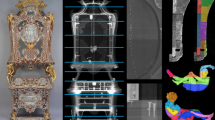Abstract
X-ray 2D imaging and 3D computed tomography are increasingly used for surveying archaeological finds and objects of cultural heritage. As examples of non-destructive methods, they can be used for the inspection of the inner structures of objects without modifying their original form. The contribution deals with the possibilities, limitations and results of a tomographic survey of a uniquely preserved hoard of coins discovered in 2020 near the village of Hradce in southern Bohemia (Czech Republic). The hoard was deposited in a ceramic vessel about 17 cm high and with a diameter of about 15 cm at the widest point. The weight of the hoard is 3.8 kg, and it contains more than 5000 coins dating back to the fourteenth and fifteenth centuries. A small number of coins are still wrapped in fabric since the fifteenth century. The contents of this fabric package in terms of the amount and type of present coins have been identified by X-ray tomography.











Similar content being viewed by others
Data Availability Statement
This manuscript has associated data in a data repository. [Authors’ comment: The datasets generated and analysed during the current study are available from the corresponding author on reasonable request.]
References
European Treaty Series - No. 143: European Convention on the Protection of the Archeological Heritage (Revised) (Council of Europe, Valetta, 1992)
J. Braga, A companion to dental anthropology, in Non-invasive Imaging Techniques. ed. by J.D. Irish, G.R. Scott (Wiley, Chichester, 2020). https://doi.org/10.1002/9781118845486.ch31
L. De Chiffre, S. Carmignato, J.P. Kruth, R.H. Schmitt, A. Weckenmann, CIRP Ann. (2014). https://doi.org/10.1016/j.cirp.2014.05.011
R.L. Abel, C.R. Laurini, M. Richter, Palaeontol. Electron. (2012). https://doi.org/10.26879/284
A. Garbacz-Klempka, Ł Karczmarek, Z. Kwak, J. Kozana, M. Piękoś, M. Perek-Nowak, P. Długosz, Arch. Found. Eng. (2018). https://doi.org/10.24425/123622
H.-E. Mahnke, Rad. Phys. Chem. (2022). https://doi.org/10.1016/j.radphyschem.2022.110323
A. D. Mc Naught, A. Wilkinson, eds., IUPAC Compendium of Chemical Terminology (Blackwell Scientific Publications, Oxford, 1997). https://doi.org/10.1351/goldbook
J. H. Hubbell, S. M.Seltzer, NIST Standard Reference Database (2004). https://doi.org/10.18434/T4D01F
J. Hsieh, Computed Tomography: Principles, Design, Artifacts, and Recent Advances (SPIE Press, Bellingham, 2009)
F. Boas, Imaging Med. 4, 229–240 (2012)
S. Jeon, G. Cho, Y. Huh, S. Jin, J. Park, Nucl. Instrum. Methods A (2006). https://doi.org/10.1016/j.nima.2006.01.136
T. Fíla, D. Vavřík, A multi-axial apparatus for carrying out x-ray measurements, particularly computed tomography (EP 2835631, 2016)
J. Miles, M. Mavrogordato, I. Sinclair, D. Hinton, R. Boardman, G. Earl, J. Archaeol. Sci.: Reports (2016). https://doi.org/10.1016/j.jasrep.2016.01.019
G.T. Ingvardson, D. Müter, B.P. Foley, J. Archaeol. Sci: Reports (2022). https://doi.org/10.1016/j.jasrep.2022.103468
B. Bakirov, I. Saprykina, S. Kichanov, R. Mimokhod, N. Sudarev, D. Kozlenko, J. Imaging (2021). https://doi.org/10.3390/jimaging7080129
A. Tengattini, N. Lenoir, E. Andò, B. Giroud, D. Atkins, J. Beaucour, G. Viggiani, Nucl. Instrum. Methods Phys. Res. Sect. A (2020). https://doi.org/10.1016/j.nima.2020.163939
H. Emmerig, Bayerns Münzgeschichte im 15. Jahrhundert: Münzpolitik und Münzprägung der bayerischen Herzogtümer und ihrer Nachbarn von 1390 bis 1470 (C. H. Beck, München 2007)
B. Koch, Corpus Nummorum Austriacorum (CNA) Band I: Mittelalter (Kunsthistorisches Museum Wien, Wien 1994)
Acknowledgements
The financial support of the project of the Ministry of Culture of the Czech Republic: Mobile device devoted to imaging and analysis of the layered paintings and polychromy of the works of old art (DG18P02OVV006) is gratefully acknowledged.
Author information
Authors and Affiliations
Corresponding author
Additional information
Focus Point on Scientific Research in Cultural Heritage 2022. Guest editors: L. Bellot-Gurlet, D. Bersani, A.-S. Le Hô, D. Neff, L. Robinet, A. Tournié.
Rights and permissions
Springer Nature or its licensor (e.g. a society or other partner) holds exclusive rights to this article under a publishing agreement with the author(s) or other rightsholder(s); author self-archiving of the accepted manuscript version of this article is solely governed by the terms of such publishing agreement and applicable law.
About this article
Cite this article
Kumpová, I., Vopálenský, M. & John, J. Possibilities and limitations of the X-ray computed tomography in the investigation of a hoard of coins from the fifteenth century. Eur. Phys. J. Plus 138, 338 (2023). https://doi.org/10.1140/epjp/s13360-023-03898-2
Received:
Accepted:
Published:
DOI: https://doi.org/10.1140/epjp/s13360-023-03898-2




